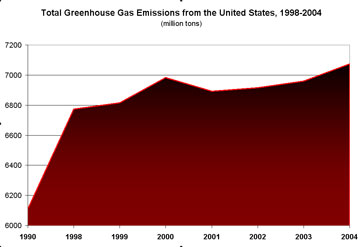US Greenhouse gas emissions hit record in 2004
Rhett A. Butler, mongabay.com
April 19, 2006
EPA findings quietly released on Monday following Easter.
Figures released Monday show that US greenhouse gas emissions hit a record in 2004, rising 1.7 percent over 2003. The increase, equivalent to a rise of 115 million tons of carbon dioxide, was the largest annual increase since 2000.
In total, the United States released the equivalent of nearly 6,300 million tons of carbon dioxide into the atmosphere. America is the world’s largest polluter in terms of greenhouse gas emissions.
The results come as concerns over climate change mount. Research released earlier this year shows that 2005 was the warmest year on record as atmospheric carbon dioxide levels rose 2.6 parts per million (ppm) to 381 ppm, the highest level in 650,000 years. Carbon dioxide levels are now about 36 percent above pre-industrial levels. Carbon dioxide is a principal “greenhouse gas” thought to be driving global warming. Humans boost carbon dioxide levels primarily by the combustion of fossils fuels and deforestation, and accordingly, atmospheric concentrations have risen sharply since the industrial revolution.
The newly released data indicate that US emissions have risen by 15.8 percent from 1990 to 2004, mainly due to “robust economic growth in 2004, leading to increased demand for electricity and fossil fuels, expanding industrial production in energy-intensive industries, also increasing demand for electricity and fossil fuels, and increased travel, leading to higher rates of consumption of petroleum fuels.” In the United States most energy use goes towards transportation according to the Energy Information Administration’s Emissions of Greenhouse Gases in the United States 2004.

|
The principle greenhouse gasses measured by the US Environmental Protection Agency (EPA) were carbon dioxide (CO2), nitrous oxide (N2O), methane (CH4), and hydroflourocarbons (HFCs), perfluorocarbons (PFCs), and sulfur hexafluoride (SF). Overall, from 1990 to 2004, total emissions of CO2 increased by the equivalent of 983 million tons. (20 percent), while CH4 and N2O emissions decreased by the equivalent of 61.3 million tons (10 percent) and 8.2 million tons (2 percent), respectively. During the same period, aggregate weighted emissions of HFCs, PFCs, and SF6 rose by 58 percent.
The United States has refused to ratify the Kyoto Protocol which calls for countries to reduce green house gas emissions from 1990 levels. Some states have taken it upon themselves to reduce emissions, with California recently introducing legistlation to impose binding limiting on future greenhouse gas emissions. The state aims to cut current levels of emissions 10 percent by 2020, to bring pollution in line with 1990 levels.
The report shows that the American economy continues to become more greenhouse gas efficient: the country has experienced 51 percent economic growth since 1990, while emissions have only risen 15.8 percent over the same period.
RELATED ARTICLES
 Global carbon dioxide emissions from human activities |
California plans to cut greenhouse gas emissions April 4, 2006
California plans to introduce legislation that will impose binding limiting on future greenhouse gas emissions. The state aims to cut current levels of emissions 10 percent by 2020, to bring pollution in line with 1990 levels. It would become the first state to implement mandatory controls on greenhouse gasses.
Report makes case for regulating carbon dioxide emissions April 5, 2006
A new report evaluating air pollution trends at the nation’s 100 largest electric power producers shows that emissions of sulfur dioxide (SO2) and nitrogen oxides (NOx) have fallen markedly in recent years, but carbon dioxide (CO2) emissions increased and will likely spike in coming years.
Record one-year increase in carbon dioxide levels March 13, 2006
A new report evaluating air pollution trends at the nation’s 100 largest electric power producers shows that emissions of sulfur dioxide (SO2) and nitrogen oxides (NOx) have fallen markedly in recent years, but carbon dioxide (CO2) emissions increased and will likely spike in coming years.
U.S. greenhouse gas emissions increase 2 percent December 19, 2005
U.S. greenhouse gas emissions increased by 2.0 percent in 2004, from 6,983.2 million metric tons carbon dioxide equivalent in 2003 to 7,122.1 metric tons in 2004, according to Emissions of Greenhouse Gases in the United States 2004, a report released today by the Energy Information Administration (EIA).
Carbon dioxide level highest in 650000 years November 24, 2005
Carbon dioxide levels are now 27 percent higher than at any point in the last 650,000 years, according to research into Antarctic ice cores published on Thursday in Science.